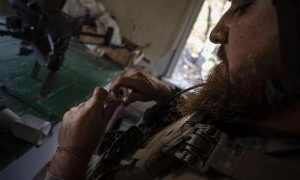In 2017, the British newspaper ‘The Guardian’ revealed the protocol drawn up by the Crown in the event of the death of Queen Elizabeth II. Named “London Bridge”, it foresees a series of announcements and tributes, and details the development of the funeral and the ceremonies that will extend for ten days.
The UK held its breath on Thursday 8 September as doctors declared Queen Elizabeth II’s condition “worrying” and much of the royal family gathered to visit her at Balmoral Palace in Scotland, where she was finally reported his death.
The death of the sovereign was a taboo in the United Kingdom: thinking about it was “blasphemy” for some Britons. However, the protocol that will follow death has been prepared for a long time so as not to leave anything to chance.
In 2017, ‘The Guardian’ had detailed this protocol in an article. An article that ‘Politico’ completed in 2021, based on documents that were to remain secret. The revelation of him would have provoked the wrath of the royal family.
The protocol in question is named after a bridge, like those of all royal funerals. The funeral of Prince Philip, Duke of Edinburgh was called “Operation Forth Bridge”. Elizabeth II’s is widely known as “Operation London Bridge.”
The announcement of death
The monarch’s medical team will monitor its latest details, filtering access to cameras and information made public.
After his death, his private secretary was in charge of giving the news to the prime minister through a secure line. The sad news was then transmitted, according to protocol, to the nations of the Commonwealth, of which Elizabeth II was also head of state. Ministers and senior officials were notified by email.
The Queen died peacefully at Balmoral this afternoon.
The King and The Queen Consort will remain at Balmoral this evening and will return to London tomorrow. pic.twitter.com/VfxpXro22W
— The Royal Family (@RoyalFamily) September 8, 2022
The home page of the royal family’s website was replaced with a black page with a brief statement confirming the death. All UK Government websites put up a black banner. Since the announcement, officials will wear a black armband, the size of which has even been fixed, as a British detail.
Flags also flew at half-staff within ten minutes of the announcement of the death. His son Carlos III, the new king, expressed the family’s great sadness at the loss of his mother: “The death of my beloved mother is a moment of greatest sadness for me and my family,” he lamented. The two houses of Parliament also closed their sessions. The members of the Government remained silent until the head of the Government, Liz Truss, spoke from 10 Downing Street, her headquarters and residence.
The day after death: Carlos III will be proclaimed king
However, the death of a sovereign implies the accession of another to the throne. On Friday the flags will be hoisted and an “Adhesion Council” will meet at the Palacio de San Jaime to proclaim Carlos as king. The proclamation is expected to take place around 11 a.m. local time. This is not to be confused with his coronation, which will not take place until a few months later. Next, a genealogist will officially baptize him with the name he chose, Carlos III.
At the same time, tomorrow the new order of succession will be proclaimed: Prince William will be the first in the order of succession and will inherit the title of Prince of Wales, while his son, George, will be the second.
Camilla Shand, until now Duchess of Cornwall, second wife of Charles, will presumably be the queen consort. Due to the hostility of a part of the British public opinion, the office of the Prince of Wales had declared in 2005 that Camilla would only be named “princess consort” if her husband acceded to the throne. However, Queen Elizabeth II publicly declared at her 2022 Diamond Jubilee her wish for her to become “queen consort”.
Regardless of the announcement by Carlos III, the new monarch will meet with the premiere in the afternoon, before attending memorial services across the country, including Edinburgh, Belfast and Cardiff.
body repatriation
Different scenarios were foreseen depending on the place of death of Elizabeth II for the repatriation of the body. Among the possibilities, there was a feared scenario that unfortunately happened: her death at Balmoral, her residence in Scotland, where the sovereign used to spend three months a year.
Upon expiration at Balmoral, “Operation Unicorn” will take place. The plan is for his body to be laid to rest in his lesser palace, Holyroodhouse, in Edinburgh. The body will then proceed to Saint Giles Cathedral for a mass, before being transferred on the royal train.
The train will then take the body back to London, where it will be transferred to the Throne Room at Buckingham Palace. However, transportation officials are very concerned about the likely presence of large crowds that will greet the convoy along the way.
The transfer to Westminster and the public tribute
According to ‘Politico’, on the fifth day of honours, the coffin will be transferred from Buckingham to the Palace of Westminster. This will be the first military parade of “Operation London Bridge”. From the sixth to the eighth day, the public will be able to come and pay their respects, 23 hours a day. Half a million people are expected to attend and planned a system of slots to avoid queues.
The Queen’s Funeral
The funeral will be held ten days after the death of the sovereign. Big Ben will ring the bell at 9am, and then a procession will carry the coffin from the Palace of Westminster to Westminster Abbey, arriving at 11am.
‘The Guardian’ then describes a frozen country: stations will stop advertising, buses will stop on the side of the road. At noon, not one, but two minutes of silence will be observed across the country. This Thursday will be declared a day of national mourning, but it will not be a holiday.
Elizabeth II will be buried in St. George’s Chapel, Windsor, next to Prince Philip, her husband who died in April 2021.












Add Comment